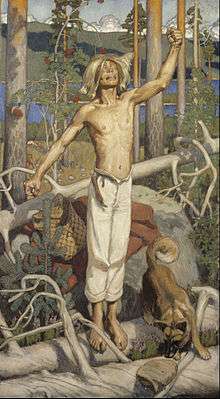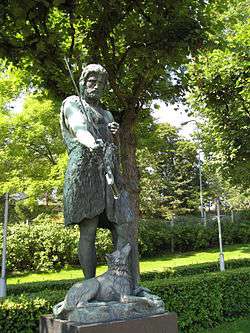Kullervo

Kullervo is an ill-fated character from the Finnish Kalevala epic. Kullervo, son of Kalervo, is the only tragic character in Finnish mythology. Growing up thinking his family was dead after the massacre of his tribe, he also recognized that he was raised by people who hated him and whom he did not trust, knowing that they were his people's murderers; he was raised by the people of Untamo, his enemy. Later, he was sold into slavery and mocked and tormented further. When he finally ran away, he finds his family, only to lose them again, and unknowingly seduces and has sexual relations with his sister, whom he thought dead. When she finds out it was her own brother who seduced her, she commits suicide. Kullervo becomes mad with rage, returns to Untamo and his tribe, exterminates them using his powers, and commits suicide. The story of Kullervo differs from all other folktales in that it describes the effects of child abuse. In the end of the poem the character Väinämöinen especially warns all parents about abusing their children. The theme was used by Filip von Schantz, Robert Kajanus, Jean Sibelius, Grahame Gordon Innes, Armas Launis and Leevi Madetoja in the Finnish culture for poems, music and in literature. An unfinished story by J.R.R. Tolkien, The Story of Kullervo, is based on the tale and was published on 27 August 2015.
Story
The story of Kullervo is laid out in runes (chapters) 31 through 36 of the Kalevala.
Rune 31 – Kullervo, son of Evil
Untamo is jealous of his brother Kalervo, and the strife between the brothers is fed by numerous petty disputes. Eventually Untamo's resentment boils into open warfare, and he kills all of Kalervo's tribe save for one pregnant woman named Untamala, who submits to Untamo. Shortly afterwards, Untamala gives birth to a baby boy she names Kullervo.
When Kullervo is three months old, he is heard uttering vows of revenge and destruction on Untamo's tribe. Untamo tries three times to have Kullervo killed (by drowning, fire, and hanging). Each time, the infant Kullervo is saved by his latent magical powers.
Untamo allows the child to grow up, then tries three times to find employment for him as a servant in his household, but all three attempts fail as Kullervo's wanton and wild nature makes him unfit for any domestic task. In the end, Untamo decides to rid himself of the problem by selling Kullervo into slavery to Ilmarinen.
Rune 32 – Kullervo as a shepherd
The boy is raised in isolation because of his status as a slave, his fierce temper, and frightening signs of early magical talent. The only memento that the boy retains from life in a loving family is an old knife that came along with him as an infant.
The wife of Ilmarinen enjoys tormenting the slave boy, now a youth, and sends Kullervo out to tend herd on her livestock with a loaf of bread with stones baked in it, along with a lengthy poem invoking the various deities to grant protection and prosperity to the herd.
Rune 33 – Kullervo and the cheat-cake
Kullervo sits down to eat, but the heirloom knife breaks on one of the stones in the bread. Kullervo is overwhelmed with rage, and, being unusually naturally gifted at magic, casts a curse that makes the cows Ilmarinen's wife is milking turn into bears, who kill her.
Rune 34 – Kullervo finds his tribe-folk
Kullervo then flees from slavery and finds that his family is actually still alive except for his sister, who has disappeared and is feared dead.
Rune 35 – Kullervo's deeds
Kullervo's father has no more success than Untamo in finding work suited for his son, and thus sends the young man to collect tributes due to the tribe. On the way back he meets a beggar-girl and seduces her without knowing or caring who she is. Afterward he realizes that she is his sister, and out of shame she commits suicide. The distraught Kullervo returns to his family to break the news.
Rune 36 – Kullervo's victory and suicide
Kullervo vows revenge on Untamo. One by one, his own family tries to dissuade him from the fruitless path of evil and revenge, and eventually rejects him, apart from his mother whose maternal love cannot be swayed even when she knows his course of action is wrong. Kullervo hardens his heart and refuses to reconsider, or even to pause to follow funeral rites when he hears his father, brother, sister and mother die in turns.
Kullervo goes on and obtains from Ukko his magic broadsword, which he uses to exterminate Untamo and his tribe. When he returns home, he finds the dead bodies of his own family littered about the homestead, untended. His mother's spirit gives him directions to woodland nymphs who can shelter him, but he finds instead the body of his sister, who committed suicide.
Kullervo then asks of Ukko's sword if it will have his life. The sword eagerly accepts, noting that as a weapon it doesn't care who it is used to kill. Kullervo commits suicide by throwing himself on his sword. On hearing the news, Väinämöinen comments that children should never be given away or ill-treated in their upbringing, lest like Kullervo they grow evil and bereft of wisdom or honor.
Evaluation
Kullervo is fairly ordinary in Finnish mythology, in being a naturally talented magician; however, he is the only irredeemably tragic example. He showed great potential, but being raised badly, he became an ignorant, implacable, immoral and vengeful man.
The death poem of Kullervo in which he, like Macbeth, interrogates his blade, is famous. Unlike the dagger in Macbeth, Kullervo's sword replies, bursting into song: it affirms that if it gladly participated in his other foul deeds, it would gladly drink of his blood also. This interrogation has been duplicated in J.R.R. Tolkien's The Children of Húrin with Túrin Turambar talking to his black sword, Gurthang, before committing suicide. (Túrin also, like Kullervo, unwittingly fell in love with his own sister and was devastated when he learned the truth, his sister also killing herself).
Some literary critics have suggested that Kullervo's character is a bitter metaphorical representation of Finland's frequent struggles for independence. Certainly Jääkärimarssi (Jäger March), a well-known Finnish military march, contains lines me nousemme kostona Kullervon/soma on sodan kohtalot koittaa (We arise like the wrath of Kullervo/so sweet are the fates of war to undergo).
The story of Kullervo is unique among ancient myths in its realistic depiction of the effects of child abuse.[1] The canto 36 ends in Väinämöinen stating that an abused child will never attain the healthy state of mind even as adult, but will grow up as a very disturbed person.
Wainamoinen, ancient minstrel,
As he hears the tidings,
Learns the death of fell Kullervo,
Speaks these words of ancient wisdom:
"O, ye many unborn nations,
Never evil nurse your children,
Never give them out to strangers,
Never trust them to the foolish!
If the child is not well nurtured,
Is not rocked and led uprightly,
Though he grow to years of manhood,
Bear a strong and shapely body,
He will never know discretion,
Never eat the bread of honor,
Never drink the cup of wisdom."
"Kullervo" from Kalevala",
- Silloin vanha Väinämöinen,
- kunpa kuuli kuolleheksi,
- Kullervon kaonneheksi,
- sanan virkkoi, noin nimesi:
- "Elkötte, etinen kansa,
- lasta kaltoin kasvatelko
- luona tuhman tuuittajan,
- vierahan väsyttelijän!
- Lapsi kaltoin kasvattama,
- poika tuhmin tuuittama
- ei tule älyämähän,
- miehen mieltä ottamahan,
- vaikka vanhaksi eläisi,
- varreltansa vahvistuisi.".[3]
Kullervo in art

Kullervo is an eponymous 1860 play by Aleksis Kivi. An English translation was published in 1993: Aleksis Kivi's Heath Cobblers and Kullervo, translated by Douglas Robinson (North Star Press of St. Cloud).
Kullervo is an eponymous 1892 choral symphony in five movements for full orchestra, two vocal soloists, and male choir by Jean Sibelius. It was opus 7 for Sibelius and his first successful work.
Kullervo's Curse (1899) and Kullervo Rides to War (1901) are two paintings by Akseli Gallen-Kallela.
In the Jäger March (Jääkärin marssi) by Jean Sibelius one of the lines goes: Me nousemme kostona Kullervon, in English: We shall rise like Kullervo's revenge.
Kullervo is the subject of a 1988 opera by Aulis Sallinen.
There is also a Sibelius-inspired Kullervo Symphony written in 2001 by English composer Grahame Gordon Innes.
Kullervo is also the subject of a brief symphonic poem composed in 1913 by Leevi Madetoja.
In 2006 a Finnish metal band Amorphis released its seventh studio album Eclipse, which tells the story of Kullervo according to a play by Paavo Haavikko. The play has been translated into English by Anselm Hollo.
The Hilliard Ensemble commissioned an English language setting of Kullervo's story, Kullervo's Message, from Veljo Tormis.
Influence on J. R. R. Tolkien
J. R. R. Tolkien wrote an interpretation of the Kullervo cycle in 1914, the piece was finally published in its unfinished form as The Story of Kullervo[4] in 2010. The published version was edited by Verlyn Flieger and was originally published in Tolkien Studies. It was re-published in book form in 2015 by HarperCollins. It was his first attempt at writing an epic narrative but was never completed.[4] The story acted as a seed for the epic tale of Túrin Turambar which features in The Silmarillion, the "Narn i Hîn Húrin" section of Unfinished Tales and, in a longer form, The Children of Húrin as well as the poem "The Lay of the Children of Húrin".
References
- ↑ www.finlit.fi
- ↑ "Translation by John Martin Crawford". www.sacred-texts.com. Retrieved 2015. Check date values in:
|access-date=(help) - ↑ "Kalevala". www.finlit.fi. Retrieved 2015. Check date values in:
|access-date=(help) - 1 2 "Tolkienin Kalevala-tarina julkaistaan sadan vuoden viipeellä – Kullervo vannoo kostoa taikuri-Untamolle" [Tolkien's Kalevala story published after a hundred-year lag – Kullervo vows revenge on Untamo the magician] (in Finnish). Retrieved 2015-06-29.
External links
-
 Media related to Kullervo at Wikimedia Commons
Media related to Kullervo at Wikimedia Commons - John Martin Crawford's English translation of the Kalevala (1888). Hosted at Sacred Texts
- Tolkien's first fantasy novel